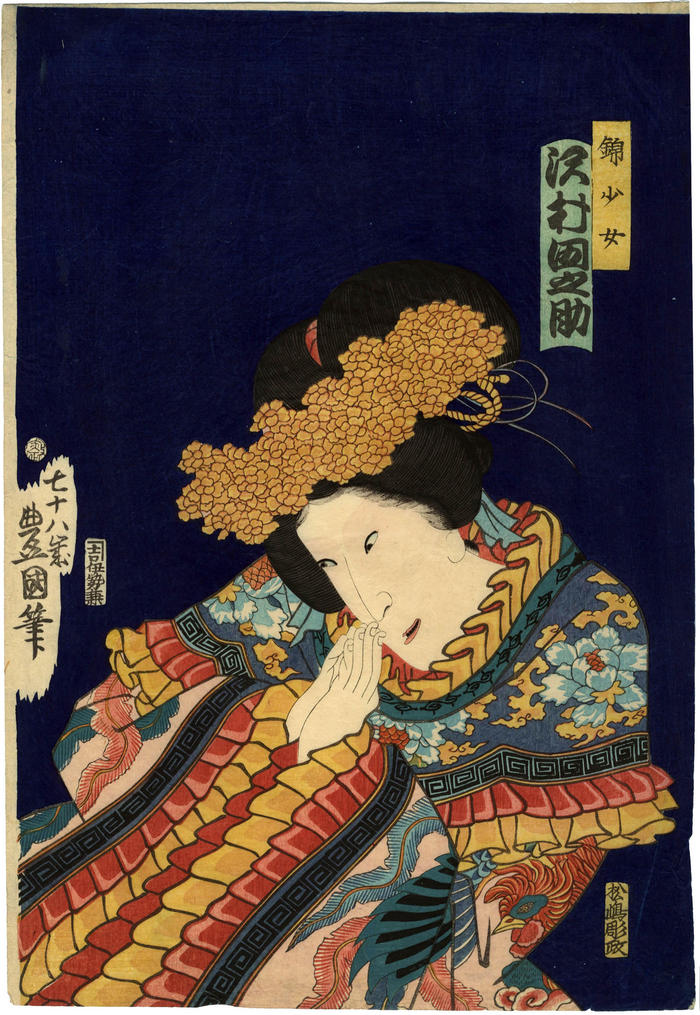Utagawa Kunisada (歌川国貞) / Toyokuni III (三代豊国) (artist 1786 – 01/12/1865)
Sawamura Tanosuke III (沢村田之助) as Princess Kinshōjo (錦少女) in Kokusenya Kassen (国性爺合戦) or Battles of Coxinga - center panel of three
01/1863
10 in x 14.75 in (Overall dimensions) Japanese color woodblock print
Signed: Shichijuhassai Toyokuni hitsu
七十八歳豊国筆
(drawn by 78 year old Toyokuni)
Publisher: Iseya Kanekichi (Marks 145 - seal 21-059)
Carver: Hori Masu (松嶋彫政)
Waseda University
Lyon Collection - another print from this series of Kanki
Hankyu Culture Foundation
Bibliothèque municipale de Rouen (via Europeana) - all three panels together
Amgueddfa Cymru (National Museum of Wales) Kinshōjo is the daughter of Ikkan, a former Ming dynasty official, and the sister of Watōnai Sankan, both of whom are determined to restore the deposed Ming rulers back onto their throne. Kinshōjo, however, is married to Kanki a former Ming loyalist who has switched sides, but whose true devotion is to her family. When her father and brother show up at her husband's castle, Kinshōjo can not let them in while her husband is away. This is where Kabuki21 picks up the story:
Finally, it is agreed that her step-mother, Nagisa, be allowed inside as long as she is bound first. She promises to put their case to her husband; if she is successful she will release white powder into the river; if not, red powder, and they should come and take Nagisa and return to Japan.
For complicated reasons, Kanki refuses to be aligned with Watônai and Kinshôjo releases red into the river, but it is her own blood. Nagisa also kills herself to join her step-daughter and this shocking result brings Watônai and Kanki together in partnership at last against the Dattan forces. Watônai accepts the new name of Kokusen'ya and together they defeat Ritôten and restore the Ming dynasty and child Emperor. (JSV)
****
The Encyclopedia Britannica says of this play: "Chikamatsu’s most popular work was Kokusenya kassen (1715; The Battles of Coxinga), a historical melodrama based loosely on events in the life of the Chinese-Japanese adventurer who attempted to restore the Ming dynasty in China."
****
This print commemorates a performance at the Nakamura Theater in the first month of 1863.
****
There is another print from this series in the Lyon Collection. It can be found at #750. Also, at #37 is an Osaka diptych related to this theme.
****
Another copy of this print is one of 116 prints which were given by a private collector to the Real Academia Nacional de Farmacia in Spain. An exhibition of these prints at the Real Academia de Bellas Artes de San Fernando identified this role as that of the Princess Kinshōjo.
****
Watonai's mother, Kinshōjo's step-mother, intercedes on her step-daughter's behalf when she is threatened by her husband.
****
The signature 七十八歳豊国筆 can also be read as: Shichiju-hassai Toyokuni hitsu.
Iseya Kanekichi (伊勢屋兼吉) (publisher)
Sawamura Tanosuke III (三代目沢村田之助: 1/1859 to July, 1878) (actor)
actor prints (yakusha-e - 役者絵) (genre)
Battle of Coxinga (Kokusenya Kassen - 国性爺合戦) (genre)
Chikamatsu Monzaemon (近松門左衛門) (author)
